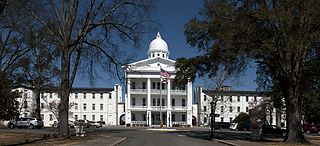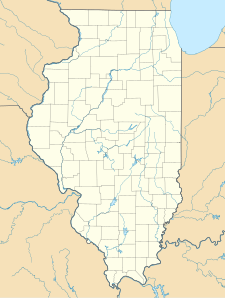
Samuel Harvey Shapiro was the 34th governor of Illinois, serving from 1968 to 1969. He was a member of the Democratic Party.

The Kirkbride Plan was a system of mental asylum design advocated by American psychiatrist Thomas Story Kirkbride (1809–1883) in the mid-19th century. The asylums built in the Kirkbride design, often referred to as Kirkbride Buildings, were constructed during the mid-to-late-19th century in the United States.

The Danvers State Hospital, also known as the State Lunatic Hospital at Danvers, The Danvers Lunatic Asylum, and The Danvers State Insane Asylum, was a psychiatric hospital located in Danvers, Massachusetts. It was built in 1874, and opened in 1878, under the supervision of prominent Boston architect Nathaniel Jeremiah Bradlee, on an isolated site in rural Massachusetts. It was a multi-acre, self-contained psychiatric hospital designed and built according to the Kirkbride Plan.

Bryce Hospital opened in 1861 in Tuscaloosa, Alabama, United States. It is Alabama's oldest and largest inpatient psychiatric facility. First known as the Alabama State Hospital for the Insane and later as the Alabama Insane Hospital, the building is considered an architectural model. The hospital currently houses 268 beds for acute care, treatment and rehabilitation of full-time (committed) patients. The Mary Starke Harper Geriatric Psychiatry Hospital, a separate facility on the same campus, provides an additional 100 beds for inpatient geriatric care. The main facility was added to the National Register of Historic Places in 1977.

The Athens Lunatic Asylum, now a mixed-use development known as The Ridges, was a Kirkbride Plan mental hospital operated in Athens, Ohio, from 1874 until 1993. During its operation, the hospital provided services to a variety of patients including Civil War veterans, children, and those declared mentally unwell. After a period of disuse the property was redeveloped by the state of Ohio. Today, The Ridges are a part of Ohio University and house the Kennedy Museum of Art as well as an auditorium and many offices, classrooms, and storage facilities.

Greystone Park Psychiatric Hospital referred to both the former psychiatric hospital and the historic building that it occupied in Morris Plains, New Jersey. Built in 1876, the facility was built to alleviate overcrowding at the state's only other "lunatic asylum" located in Trenton, New Jersey.

Agnews Developmental Center was a psychiatric and medical care facility, located in Santa Clara, California.

Peoria State Hospital Historic District, also known as Bartonville State Hospital or Illinois Asylum for the Incurable Insane, was a psychiatric hospital operated by the State of Illinois from 1902 to 1973. The hospital is located in Bartonville, Illinois, near the city of Peoria in Peoria County. The hospital grounds and its 63 buildings are listed as a historic district on the National Register of Historic Places.
Mendota Mental Health Institute (MMHI) is a public psychiatric hospital in Madison, Wisconsin, United States, operated by the Wisconsin Department of Health Services. The hospital is accredited by the Joint Commission. Portions of the facility are included in the Wisconsin Memorial Hospital Historic District, District #88002183. The Mendota State Hospital Mound Group and Farwell's Point Mound Group are also located at the facility.

The Hudson River State Hospital is a former New York state psychiatric hospital which operated from 1873 until its closure in the early 2000s. The campus is notable for its main building, known as a "Kirkbride," which has been designated a National Historic Landmark due to its exemplary High Victorian Gothic architecture, the first use of that style for an American institutional building. It is located on US 9 on the Poughkeepsie-Hyde Park town line.

The Elgin Mental Health Center is a mental health facility operated by the State of Illinois in Elgin, Illinois. Throughout its history, Elgin's mission has changed. At times, it treated mental illness, tuberculosis, and provided federally funded care for veterans. The hospital's site, which included a patient-staffed farm reached a maximum of 1,139 acres (461 ha) after World War II. Its maximum population was reached in the mid 1950s with 7,700 patients. Between 1993 and 2008, most of the older buildings in the complex were demolished due to being in poor condition as the result of being abandoned for decades. The site is/was popular among teens and in the paranormal world due to its claims of hauntings in the older buildings and the hospital's cemetery.
The Jacksonville Developmental Center was an institution for developmentally delayed clients, located in Jacksonville, Illinois. It was open from 1851 to November 2012. As of December 2012, the 134-acre (54 ha) grounds was still owned by the State of Illinois.
The Chester Mental Health Center is the only State of Illinois' maximum security forensic mental health facility for those committed via a court order or deemed an escape risk. The facility is operated by the State of Illinois in Chester, Illinois, and is a part of the Illinois Department of Human Services, formerly the Illinois Department of Mental Health and Developmental Disabilities. It is adjacent to the Menard Correctional Center. The other secure mental health center in Illinois is Elgin Mental Health Center, which houses women as well as men. Chester Mental Health Center is a men's facility.
The Mabley Developmental Center is a state institution for people with developmental disabilities located in Dixon, Illinois. It is named for Jack Mabley, a Chicago columnist, in recognition of his unstinting support for the project.

Winnebago Mental Health Institute (WMHI), formerly the Winnebago State Hospital, is a psychiatric hospital near Oshkosh, Wisconsin, United States located in the unincorporated community of Winnebago, Wisconsin.
The Mount Pleasant Mental Health Institute was a psychiatric institution located in Mount Pleasant, Iowa, USA. Originally known as the Iowa Lunatic Asylum, it opened in 1861. It is located on the same campus as The Mount Pleasant Correctional Facility. There was also a labyrinth of tunnels which connected every building. It was the first asylum in Iowa and was built under the Kirkbride Plan.

The Arkansas Department of Human Services (DHS) is a state agency of Arkansas, headquartered in Donaghey Plaza South of the Donaghey Complex, a five-story building on the southwest corner of Main Street and 7th Street, in Little Rock.

The Independence State Hospital was built in 1873 as the second asylum in the state of Iowa. It is located in Independence, Iowa. The original plan for patients was to relieve crowding from the hospital at Mount Pleasant and to hold alcoholics, geriatrics, drug addicts, mentally ill, and the criminally insane. It was built under the Kirkbride Plan. The hospital's many names include: The Independence Lunatic Asylum, The Independence State Asylum, The Independence Asylum for the Insane, The Iowa State Hospital for the Insane, and The Independence Mental Health Institute. There is also a labyrinth of tunnels which connect every building. Like most asylums of its time, it has had a gruesome and dark history. Remnants of this are the graveyard, hydrotherapy tubs, and lobotomy equipment.

The Fergus Falls Regional Treatment Center is a former hospital located in Fergus Falls, Minnesota. It was built in the Kirkbride Plan style and first opened to patients in 1890. Over the next century it operated as one of the state's main hospitals for the mentally ill and also worked with people with developmental disabilities and chemical dependency issues. It was added to the National Register of Historic Places in 1986.
Anna State Hospital, contemporarily known as Choate Mental Health and Developmental Center, is a public psychiatric hospital in Anna, Illinois, established in 1869. The original hospital was constructed under the Kirkbride Plan.















